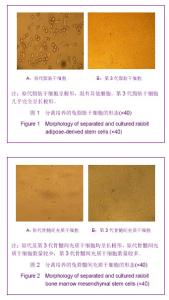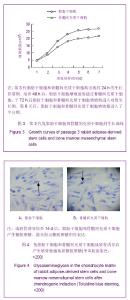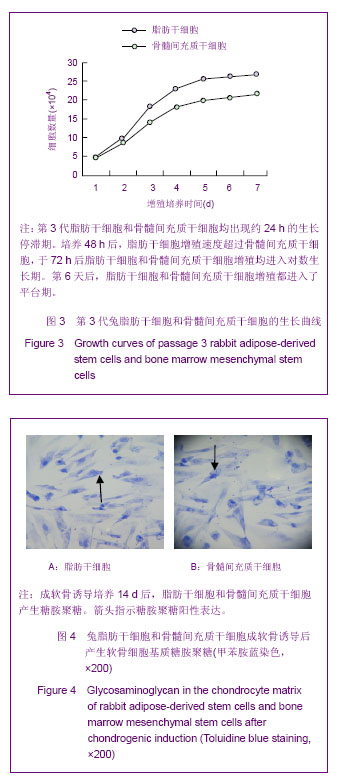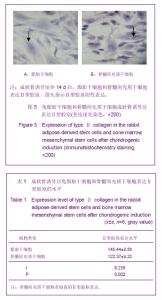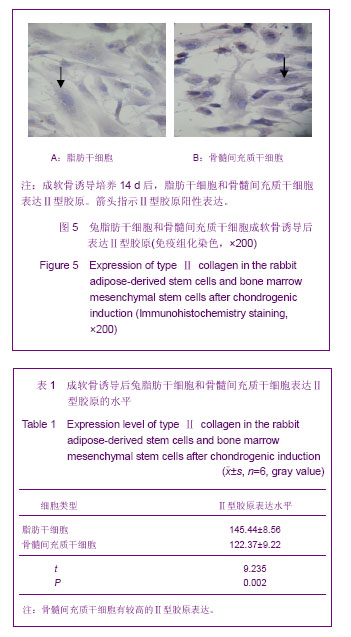| [1] Poulsom R, Forbes SJ, Hodivala-Dilke K, et al. Bone marrow contributes to renal parenchymal turnover and regeneration. J Pathol. 2001;195(2):229-235.[2] Nayyer L, Patel KH, Esmaeili A, et al. Tissue engineering: revolution and challenge in auricular cartilage reconstruction. Plast Reconstr Surg. 2012;129(5):1123-1137. [3] Morigi M, Imberti B, Zoja C, et al. Mesenchymal stem cells are renotropic, helping to repair the kidney and improve function in acute renal failure. J Am Soc Nephrol. 2004;15(7):1794-1804.[4] Hamid AA, Idrus RB, Saim AB, et al. Characterization of human adipose-derived stem cells and expression of chondrogenic genes during induction of cartilage differentiation. Clinics (Sao Paulo). 2012;67(2):99-106.[5] Mödder UI, Roforth MM, Nicks KM, et al. Characterization of mesenchymal progenitor cells isolated from human bone marrow by negative selection. Bone. 2012;50(3):804-810. [6] Vishnubalaji R, Al-Nbaheen M, Kadalmani B, et al. Comparative investigation of the differentiation capability of bone-marrow- and adipose-derived mesenchymal stem cells by qualitative and quantitative analysis. Cell Tissue Res. 2012; 347(2):419-427. [7] 杨中萌,尹震宇,叶志坚,等.大鼠脂肪和骨髓来源间充质干细胞的生物学特性比较[J].中国组织工程研究与临床康复,2010,14(23): 4211-4216.[8] 安荣泽,王兆杰,张强,等.改良诱导方案诱导SD大鼠脂肪源性干细胞定向分化为软骨细胞[J].中国组织工程研究与临床康复, 2009,13(36):7052-7057.[9] Mithoefer K, Williams RJ 3rd, Warren RF, et al. The microfracture technique for the treatment of articular cartilage lesions in the knee. A prospective cohort study. J Bone Joint Surg Am. 2005;87(9):1911-1920.[10] Lee RH, Kim B, Choi I, et al. Characterization and expression analysis of mesenchymal stem cells from human bone marrow and adipose tissue. Cell Physiol Biochem. 2004; 14(4-6):311-324.[11] Strem BM, Hicok KC, Zhu M, et al. Multipotential differentiation of adipose tissue-derived stem cells. Keio J Med. 2005;54(3):132-141.[12] Zuk PA, Zhu M, Mizuno H, et al. Multilineage cells from human adipose tissue: implications for cell-based therapies. Tissue Eng. 2001;7(2):211-228.[13] Gronthos S, Franklin DM, Leddy HA, et al. Surface protein characterization of human adipose tissue-derived stromal cells. J Cell Physiol. 2001;189(1):54-63.[14] Baksh D, Yao R, Tuan RS. Comparison of proliferative and multilineage differentiation potential of human mesenchymal stem cells derived from umbilical cord and bone marrow. Stem Cells. 2007;25(6):1384-1392.[15] 王兆杰,安荣泽,张强,等.利用脂肪干细胞构建软骨修复兔膝关节软骨缺损的初步研究[J].中国骨质疏松杂志,2009,15(7): 501-505.[16] 杨震,简月奎,安荣泽,等.SD大鼠脂肪干细胞的体外分离培养及实验研究[J].贵州医学,2008,32(5):54-58.[17] 李松军,安荣泽,谢伟.TGF-β1和bFGFs体外诱导成人骨髓间充质干细胞表达软骨细胞表型的实验研究[J].中国矫形外科杂志. 2005,13(5):608-611.[18] 王兆杰,安荣泽,袁小洪.重组腺相关病毒介导转化生长因子-β1基因修饰ADSCs成软骨细胞的研究[J].中华实验外科杂志,2010, 27(12);1958-1958.[19] 中华人民共和国科学技术部. 关于善待实验动物的指导性意见.2006-09-30.[20] 刘坤,罗军,娄繁,等.大鼠骨髓基质细胞的体外培养和鉴定[J].中国普外基础与临床杂志,2009,16(11):875-879.[21] 黄谦,吴涛,梁杰,等.全骨髓培养法和密度梯度离心法分离hBMSCs的比较研究[J].中国修复重建外科杂志,2009, 23(11): 1360-1364.[22] Rebelatto CK, Aguiar AM, Moretão MP, et al. Dissimilar differentiation of mesenchymal stem cells from bone marrow, umbilical cord blood, and adipose tissue. Exp Biol Med (Maywood). 2008;233(7):901-913. [23] 余方圆,卢世璧,赵斌,等.脂肪干细胞与骨髓干细胞生物学性状的比较[J].中华实验外科杂志,2009,26(3):396.[24] Winter A, Breit S, Parsch D, et al. Cartilage-like gene expression in differentiated human stem cell spheroids: a comparison of bone marrow-derived and adipose tissue-derived stromal cells. Arthritis Rheum. 2003;48(2): 418-429. |
